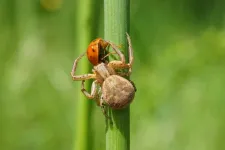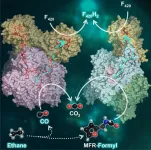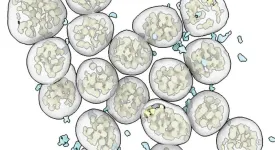(Press-News.org) Speaking, singing, coughing, laughing, yelling, yawning, chewing—we use our jaws for many purposes. Each action requires a complex coordination of muscles whose activity is managed by neurons in the brain.
But it turns out that the neural circuit behind the jaw movement most essential to survival—eating—is surprisingly simple, as researchers from Rockefeller University recently described in a new paper in Nature. Christin Kosse and other scientists from the Laboratory of Molecular Genetics, headed by Jeffrey M. Friedman, have identified a three-neuron circuit that connects a hunger-signaling hormone to the jaw movements of chewing. The intermediary between these two is a cluster of neurons in a specific area of the hypothalamus that, when damaged, has long been known to cause obesity.
Strikingly, inhibiting these so-called BDNF neurons not only leads animals to consume more food but also triggers the jaw to make chewing motions even in the absence of food or other sensory input that would indicate it was time to eat. And stimulating them reduces food intake and puts a halt to the chewing motions, acting as an effective curb against hunger.
The simple architecture of this circuit suggests that the impulse to eat may be more similar to a reflex than was previously considered—and may provide a new clue about how the initiation of feeding is controlled.
“It’s surprising that these neurons are so keyed to motor control,” says study first author Christin Kosse, a research associate in the lab. “We didn’t expect that limiting physical jaw motion could act as a kind of appetite suppressant.”
More than a feeling?
The impulse to eat is driven not just by hunger but by many factors. We also eat for pleasure, community, ritual, and habit; and smell, taste, and emotions can impact whether we eat too. In humans, eating can also be regulated by the conscious desire to consume more or less. The causes of obesity are equally complex, the result of a dynamic interplay of diet, environment, and genes. For example, mutations in several genes, including leptin, the hunger-suppressing hormone, and brain-derived neurotrophic factor (BDNF), lead to gross overeating, metabolic changes, and extreme obesity, suggesting that both factors normally suppress appetite.
When Friedman’s team began this study, they sought to pinpoint the location of the BDNF neurons that curtail overeating. That’s eluded scientists for years, because BDNF neurons, which are also primary regulators of neuronal development, differentiation, and survival, are widespread in the brain.
In the current study, they homed in on the ventromedial hypothalamus (VMH), a deep-brain region linked to glucose regulation and appetite. It’s well-documented that damage in the VMH can lead to overeating and eventually obesity in animals and people, just as mutated BDNF proteins do. Perhaps the VMH played a regulatory role in feeding behavior.
They hoped that by documenting BDNF’s impact on eating behavior, they could find the neural circuit underpinning the process of transforming sensory signals into jaw motions. They subsequently found that BDNF neurons in the VMH—but not elsewhere—are activated when animals become obese, suggesting that they are activated when weight is gained in order to suppress food intake. Thus when these neurons are missing, or there is a mutation in BDNF, animals become obese.
Chewing without food
In a series of experiments, the researchers then used optogenetics to either express or inhibit the BDNF neurons in the ventromedial hypothalamus of mice. When the neurons were activated, the mice completely stopped feeding, even when they were known to be hungry. Silencing them had the opposite effect: the mice began to eat—and eat and eat and eat, wolfing down nearly 1200% more food than they normally would in a short period of time.
“When we saw these results, we initially thought that perhaps BDNF neurons encode valence,” Kosse says. “We wondered if when we regulated these neurons, the mice were experiencing the negative feeling of hunger or maybe the positive feeling of eating food that’s delicious.”
But subsequent experiments disproved that idea. Regardless of the food given to the mice—either their standard chow or food packed with fat and sugar, like the mouse equivalent of a chocolate mousse cake—they found that activating the BDNF neurons suppressed food intake.
And because hunger is not the only motivation to eat—as anyone unable to skip dessert can attest—they also offered high-palatable food to mice that were already well fed. The animals chowed down until the researchers inhibited the BDNF neurons, at which point they promptly stopped eating.
“This was initially a perplexing finding, because prior studies have suggested that this ‘hedonic’ drive to eat for pleasure is quite different from the hunger drive, which is an attempt to suppress the negative feeling, or negative valence, associated with hunger by eating,” Kosse notes. “We demonstrated that activating BDNF neurons can suppress both drives.”
Equally striking was that BDNF inhibition caused the mice to make chewing motions with their jaw, directed at any object in their vicinity even when food was not available. This compulsion to chew and bite was so strong that the mice gnawed on anything around them—the metal spout of a water feeder, a block of wood, even the wires monitoring their neural activity.
The circuit
But how does this motor-control switch connect to the body’s need or desire for food?
By mapping the inputs and outputs of the BDNF neurons, the researchers discovered that BDNF neurons are the linchpin of a three-part neural circuit linking hormonal signals that regulate appetite to the movements required to consume it.
At one end of the circuit are special neurons in the arcuate nucleus (Arc) region of the hypothalamus that pick up hunger signals such as the hormone leptin, which is produced by fat cells. (A high amount of leptin means the energy tank is full, while a low leptin level indicates it’s time to eat. Animals with no leptin become obese.) The Arc neurons project to the ventromedial hypothalamus, where their signals are picked up by the BDNF neurons, which then project directly to a brainstem center called Me5 that controls the movement of jaw muscles.
“Other studies have shown that when you kill Me5 neurons in mice during development, the animals will starve because they’re unable to chew solid foods,” says Kosse. “So it makes sense that when we manipulate the BDNF neurons projecting there, we see jaw movements.”
It also explains why damage in the VMH causes obesity, Friedman says. “The evidence presented in our paper shows that the obesity associated with these lesions is a result of a loss of these BDNF neurons, and the findings unify the known mutations that cause obesity into a relatively coherent circuit.”
The findings suggest something deeper about the connection between sensation and behavior, he adds. “The architecture of the feeding circuit is not very different from the architecture of a reflex,” says Friedman. “That’s surprising, because eating is a complex behavior—one in which many factors influence whether you'll initiate the behavior, but none of them guarantee it. On the other hand, a reflex is simple: a defined stimulus and an invariant response. In a sense, what this paper shows is that the line between behavior and reflex is probably more blurred than we thought. We hypothesize that the neurons in this circuit are the target of other neurons in the brain that convey other signals that regulate appetite.”
This hypothesis is consistent with the work of early 20th century neurophysiologist Charles Sherrington, who pointed out that while cough is regulated by a typical reflex, it can be modulated by conscious factors, such as the desire to suppress it in a crowded theater.
Kosse adds, “Because feeding is so essential to basic survival, this circuit regulating food intake may be ancient. Perhaps it was a substrate for ever-more complex processing that occurred as the brain evolved.”
To that end, in the future the researchers want to explore the brainstem area known as Me5 with the idea that the jaw’s motor controls might be a useful model for understanding other behaviors, including compulsive, stress-related mouth actions such as gnawing on a pencil eraser or strands of one’s hair.
“By examining these premotor neurons in the Me5, we might be able to understand whether there are other centers that project into the region and influence other innate behaviors, like BDNF neurons do for eating,” she says. “Are there stress-activated or other neurons that project into there as well?”
END
The decision to eat may come down to these three neurons
2024-10-23
ELSE PRESS RELEASES FROM THIS DATE:
Woods Hole Oceanographic Institution researchers use the sounds of healthy coral reefs to encourage growth of a new species of coral larvae
2024-10-23
Woods Hole, Mass. – Coral reefs worldwide are in trouble. These ecosystems support a billion people and more than a quarter of marine species. Still, many have been damaged by unsustainable fishing and tourism, coastal construction, nutrient runoff, and climate change. Now, researchers have shown that broadcasting the sounds of healthy reefs is a way to encourage larval corals to repopulate degraded sites and help revitalize them.
A recent study done by researchers at the Woods Hole Oceanographic Institution (WHOI) showed that golfball coral larvae can be encouraged to settle when they hear the sounds of a vibrant, healthy reef. This is the second coral species ...
Researchers at NYU Tandon School of Engineering and KAIST develop method to 'hear' defects in promising nanomaterial
2024-10-23
An international research team led by NYU Tandon School of Engineering and KAIST (Korea Advanced Institute of Science and Technology) has pioneered a new technique to identify and characterize atomic-scale defects in hexagonal boron nitride (hBN), a two-dimensional (2D) material often dubbed "white graphene" for its remarkable properties.
This advance could accelerate the development of next-generation electronics and quantum technologies.
The team reported that it was able to detect the presence of individual carbon atoms replacing boron atoms in hBN crystals. This discovery was made possible by listening to ...
Biodiversity increases nutrient availability
2024-10-23
Animals not only need sufficient calories to function, but also essential nutrients — including omega-3 and omega-6 polyunsaturated fatty acids (PUFA). Insects and arachnids are an important source of these essential fatty acids for birds, hedgehogs, lizards and the like. However, the content depends on the specific types of insects and spiders consumed. Aquatic insects, such as caddisflies or dragonflies, contain significantly more omega-3 long-chain (LC) PUFA than terrestrial insects because omega-3- LC-PUFA rich algae form the base of the food chain in aquatic ecosystems.
The ...
American Society of Anesthesiologists names Donald E. Arnold, M.D., FACHE, FASA, new president
2024-10-23
PHILADELPHIA — Donald E. Arnold, M.D., FACHE, FASA, chair of the Department of Anesthesiology, Mercy Hospital in St. Louis and member of the board of directors of Western Anesthesiology Associates, Inc., in Ballwin, Missouri, was today named president of the American Society of Anesthesiologists (ASA), the nation’s largest organization of anesthesiologists. Dr. Arnold assumed office at the ANESTHESIOLOGY® 2024 annual meeting and will serve for one year.
“I’m honored to be named president of ASA and committed to serving our members, supporting the Society’s mission to advance the specialty, preserving physician-led anesthesia care, and above ...
Family as a wealth factor
2024-10-23
Wealth is one of the strongest indicators of social status, acting as a key indicator of social inequality and influencing access to education, health care and professional success. In a study, researchers from the Max Planck Institute for Demographic Research, the University of Cologne, GESIS and the Norwegian Institute of Public Health examined how financial wealth changes related to various generational transitions within families. The study used data from Norwegian registries and focused on people born in 1953.
Investigating changes in wealth within the ...
Breathing deep: A metabolic secret of ethane-consuming archaea unraveled
2024-10-23
Seeps on the deep seafloor naturally emit alkanes, which are pollutants that are potentially dangerous to life and act on global warming. Fortunately, the sediments around the seeps host microbes that act as a biological filter: They consume most of the alkanes before their release into the oceans and our atmosphere. This so-called anaerobic oxidation of alkanes is an important yet poorly understood microbial process. Scientists from the Max Planck Institute for Marine Microbiology in Bremen, Germany, now ...
NIH clinical trial will test precision medicine treatments for myeloid cancers
2024-10-23
The National Institutes of Health (NIH) has launched a proof-of-concept precision medicine clinical trial to test new treatment combinations targeting specific genetic changes in the cancer cells of people with acute myeloid leukemia (AML) and myelodysplastic syndromes (MDS). The trial, funded by NIH’s National Cancer Institute (NCI), aims to accelerate the discovery of more tailored treatments for these aggressive cancers of the blood and bone marrow.
“AML and MDS are a heterogeneous group of cancers that can progress very quickly. Treatment advances depend in part on the ability to rapidly identify which subtype of cancer each patient has so that treatments can be tested for ...
Novel antibody platform tackles viral mutations
2024-10-23
New York, NY, October 23, 2024 — Scientists at the Icahn School of Medicine at Mount Sinai, in collaboration with colleagues in the field, have developed an innovative antibody platform aimed at tackling one of the greatest challenges in treating rapidly evolving viruses like SARS-CoV-2: their ability to mutate and evade existing vaccines and therapies.
Their findings, including preclinical studies in mice, introduce the Adaptive Multi-Epitope Targeting and Avidity-Enhanced (AMETA) Nanobody Platform, a new antibody approach for addressing how viruses like SARS-CoV-2, which causes COVID-19, evolve to evade vaccines and treatments. Details on the results were published October 23 ...
myeloMATCH precision medicine trials in myeloid leukemias open to patient enrollment across US and Canada
2024-10-23
Four leading cancer research organizations in the United States and Canada announce the opening of patient enrollment to myeloMATCH, a unique portfolio of clinical trials to test precision medicine treatments for adults with acute myeloid leukemia (AML) or myelodysplastic syndrome (MDS).
The Alliance for Clinical Trials in Oncology, Canadian Cancer Trials Group, ECOG-ACRIN Cancer Research Group, and SWOG Cancer Research Network are collaborating within the National Cancer Institute (NCI) National Clinical Trials Network (NCTN) to design and lead the trials. They expect to open ...
Social determinants of health and US health care expenditures by insurer
2024-10-23
About The Study: In this cross-sectional study of 14,000 insured adults, individual-level social determinants of health were significantly associated with U.S. health care expenditures by Medicare, Medicaid, and private insurers. These findings may inform health insurers and policymakers to incorporate social determinants of health in their decision-making practices to identify and control health care expenditures, advancing health equity.
Corresponding Author: To contact the corresponding author, Giridhar Mohan, MPH, email gmohan1@jhu.edu.
To access the embargoed study: Visit our For The Media website at this link https://media.jamanetwork.com/
(doi:10.1001/jamanetworkopen.2024.40467)
Editor’s ...



